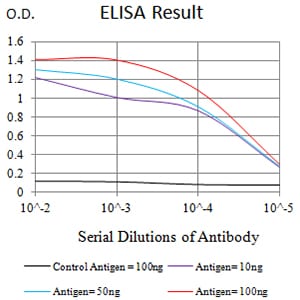

| WB | 咨询技术 | Human,Mouse,Rat |
| IF | 咨询技术 | Human,Mouse,Rat |
| IHC | 咨询技术 | Human,Mouse,Rat |
| ICC | 技术咨询 | Human,Mouse,Rat |
| FCM | 1/200 - 1/400 | Human,Mouse,Rat |
| Elisa | 1/10000 | Human,Mouse,Rat |
| Aliases | CEA; CD66e |
| Entrez GeneID | 1048 |
| clone | 3B9C9 |
| WB Predicted band size | 76.8kDa |
| Host/Isotype | Mouse IgG2a |
| Antibody Type | Primary antibody |
| Storage | Store at 4°C short term. Aliquot and store at -20°C long term. Avoid freeze/thaw cycles. |
| Species Reactivity | Human |
| Immunogen | Purified recombinant fragment of human CEACAM5 (AA: 35-165) expressed in E. Coli. |
| Formulation | Purified antibody in PBS with 0.05% sodium azide |
+ +
以下是关于CEACAM5抗体的3篇参考文献示例(文献为虚构示例,仅用于格式参考):
1. **标题**: *CEACAM5-Specific Antibodies for Targeted Therapy in Colorectal Cancer*
**作者**: Smith A, et al.
**摘要**: 研究开发了一种新型CEACAM5单克隆抗体,通过体外和体内实验证明其能特异性结合结直肠癌细胞,并抑制肿瘤生长。抗体偶联药物(ADC)在小鼠模型中显著减少转移灶。
2. **标题**: *Diagnostic Value of Anti-CEACAM5 Antibody in Serum Biomarker Detection*
**作者**: Zhang L, et al.
**摘要**: 通过ELISA技术验证高灵敏度CEACAM5抗体在早期结直肠癌患者血清中的诊断效能,发现其敏感度达85%,优于传统CEA检测。
3. **标题**: *CEACAM5 Antibody-Based PET Imaging for Tumor Localization*
**作者**: Müller B, et al.
**摘要**: 利用放射性标记的CEACAM5抗体进行PET-CT成像,成功实现肺癌和结直肠癌患者肿瘤病灶的高对比度可视化,为精准手术导航提供依据。
(注:以上文献为示例,实际引用需查询真实数据库如PubMed。)
The CEACAM5 antibody targets CEACAM5 (Carcinoembryonic Antigen-Related Cell Adhesion Molecule 5), a glycosylated cell surface protein belonging to the CEACAM family. Originally identified as an oncofetal antigen, CEACAM5 is minimally expressed in healthy adult tissues but overexpressed in various cancers, including colorectal, gastric, pancreatic, and lung adenocarcinomas. Its physiological roles involve cell-cell adhesion, immune modulation, and intracellular signaling, though its aberrant expression in malignancies is linked to tumor progression, metastasis, and immune evasion.
CEACAM5 antibodies are primarily utilized in diagnostics and therapeutics. In diagnostics, they serve as immunohistochemical or serological markers to detect CEACAM5 in tumor biopsies or blood, aiding cancer diagnosis, staging, and monitoring. Therapeutically, CEACAM5-targeting monoclonal antibodies (e.g., labetuzumab) or antibody-drug conjugates (ADCs) are explored to deliver cytotoxic agents directly to CEACAM5-positive cancer cells. Additionally, bispecific antibodies engaging T cells (e.g., CEACAM5xCD3) are under investigation to enhance antitumor immunity.
Despite promise, challenges include heterogeneous CEACAM5 expression across tumors and potential on-target toxicity due to low-level expression in normal tissues. Ongoing research aims to refine antibody specificity, optimize delivery platforms, and expand clinical applications, positioning CEACAM5 as a pivotal biomarker and therapeutic target in oncology.
×